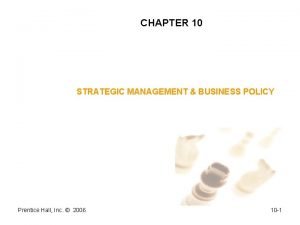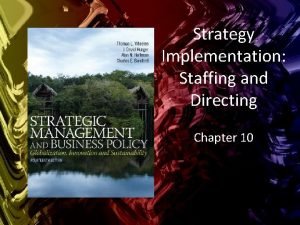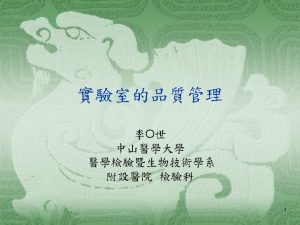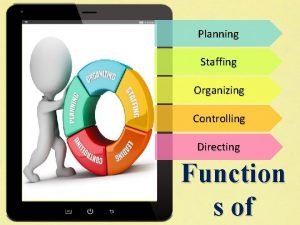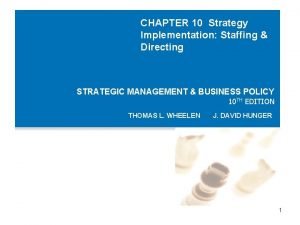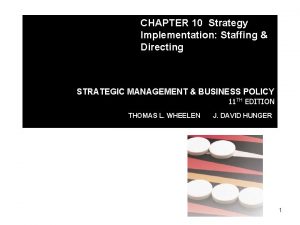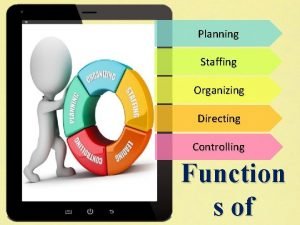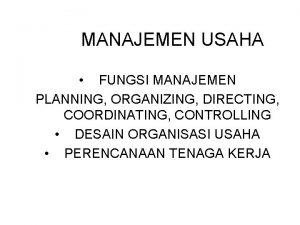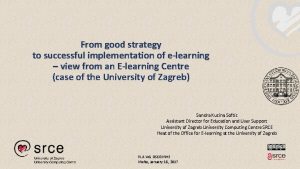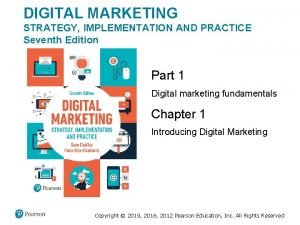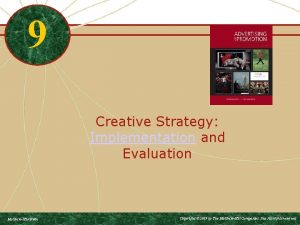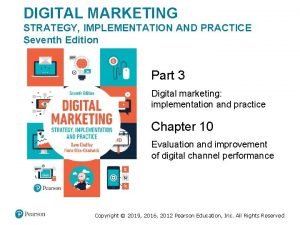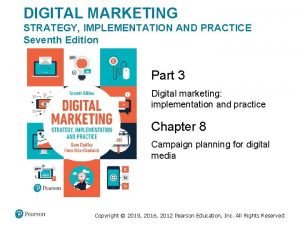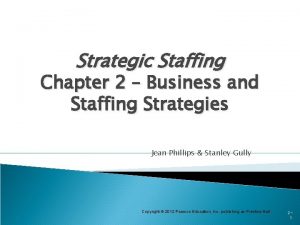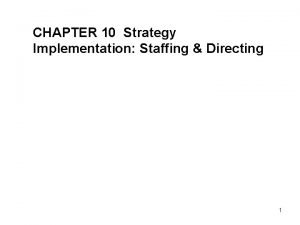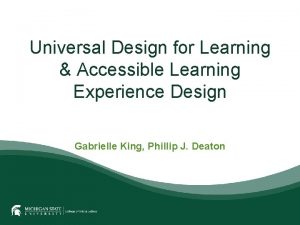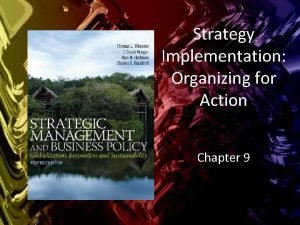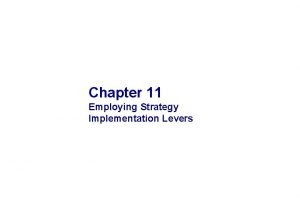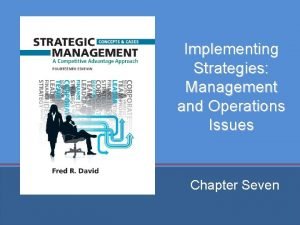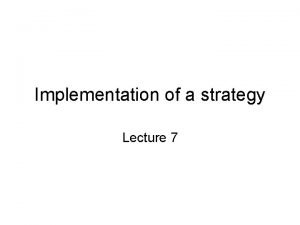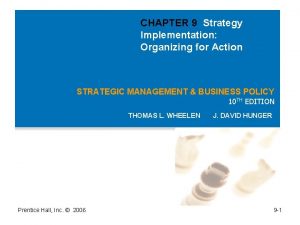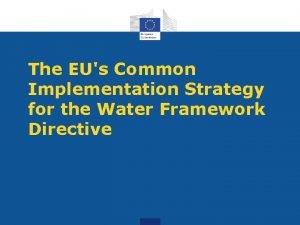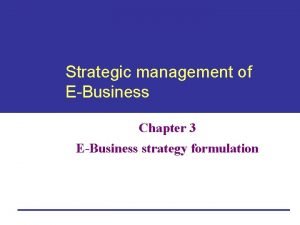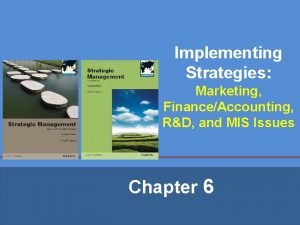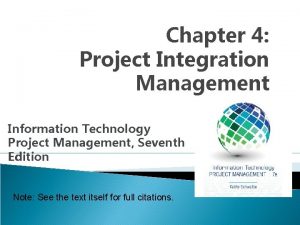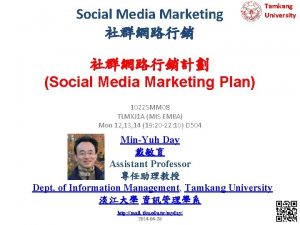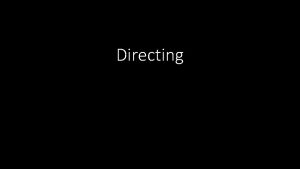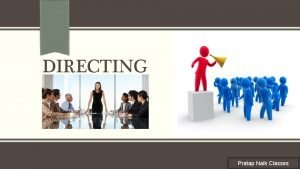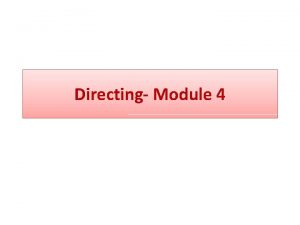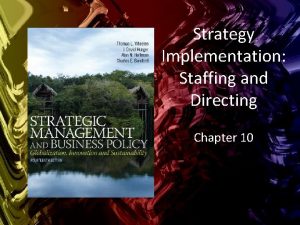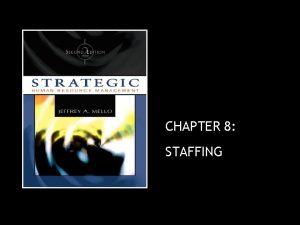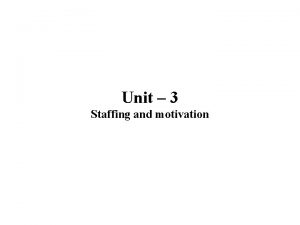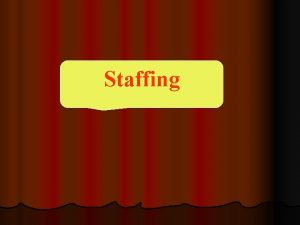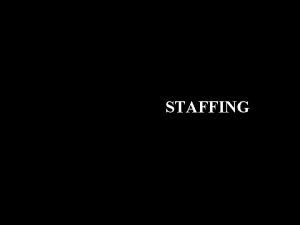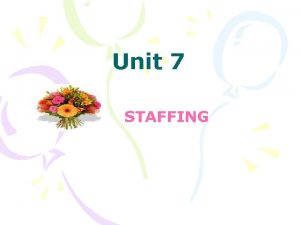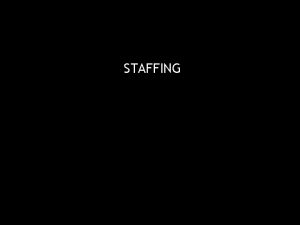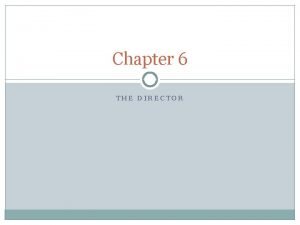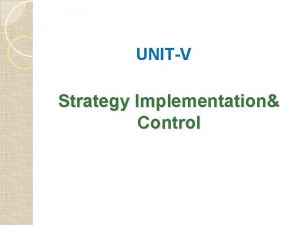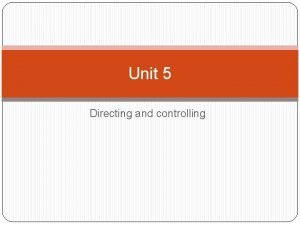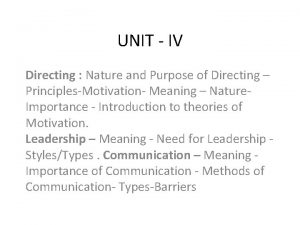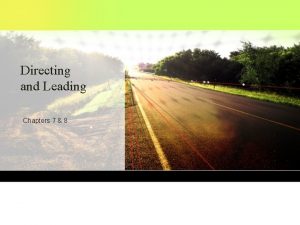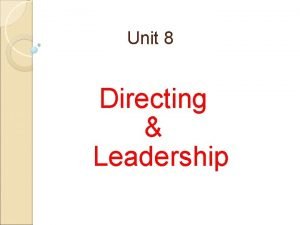Strategy Implementation Staffing and Directing Chapter 10 Learning



































- Slides: 35

Strategy Implementation: Staffing and Directing Chapter 10

Learning Objectives ª Understand the link between strategy and staffing decisions ª Match the appropriate manager to the strategy ª Understand how to implement an effective downsizing program ª Discuss important issues in effectively staffing and directing international expansion ª Assess and manage the corporate culture’s fit with a new strategy ª Formulate effective action plans when MBO and TQM are determined to be appropriate methods of strategy implementation Copyright © 2015 Pearson Education, Inc. 10 -2

Integration Managers ª Prepare a competitive profile of the company in terms of its strengths and weaknesses ª Draft a profile of what the ideal combined company should look like ª Develop action plans to close the gap between actual and ideal ª Establish training programs to unite the combined company and make it more competitive Copyright © 2015 Pearson Education, Inc. 10 -3

Staffing To be a successful integration manager, a person should have: ª Deep knowledge of the acquiring company ª Flexible management style ª Ability to work in cross-functional teams ª Willingness to work independently ª Sufficient emotional and cultural intelligence to work in a diverse environment Copyright © 2015 Pearson Education, Inc. 10 -4

Staffing Follows Strategy ªOne way to implement a company’s business strategy, such as overall low cost, is through training and development. ªExecutive characteristics influence strategic outcomes for a corporation. Copyright © 2015 Pearson Education, Inc. 10 -5

Matching the Manager to the Strategy ªExecutive type 9 executives with a particular mix of skills and experiences 9 paired with a specific corporate strategy Copyright © 2015 Pearson Education, Inc. 10 -6

Executive Types Dynamic industry expert Analytical portfolio manager Turnaround specialist Cautious profit planner Professional liquidator Copyright © 2015 Pearson Education, Inc. 10 -7

Selection and Management Development ªExecutive succession 9 process of replacing a key top manager ªSuccession planning 9 identifying candidates below the top layer of management 9 measuring internal candidates against external candidates 9 providing financial incentives Copyright © 2015 Pearson Education, Inc. 10 -8

Identifying Abilities and Potential ªPerformance appraisal systems identify good performers with promotion potential. ªAssessment centers evaluate a person’s suitability for an advanced position. ªJob rotation ensures employees are gaining a mix of experience to prepare them for future responsibilities. Copyright © 2015 Pearson Education, Inc. 10 -9

Problems in Retrenchment ªDownsizing 9 the planned elimination of positions or jobs 9 also called “rightsizing” or “resizing” ª Can damage the learning capacity of an organization ª Creativity drops significantly and it becomes very difficult to keep high performers from leaving the company Copyright © 2015 Pearson Education, Inc. 10 -10

Guidelines for Successful Downsizing ª Eliminate unnecessary work instead of making across the board cuts ª Contract out work that others can do cheaper ª Plan for long-run efficiencies ª Communicate the reasons for actions ª Invest in the remaining employees ª Develop value added jobs to balance out job elimination Copyright © 2015 Pearson Education, Inc. 10 -11

International Issues in Staffing Companies that do a good job of managing foreign assignments follow three general practices: ª When making international assignments, they focus on transferring knowledge and developing global leadership. ª They make foreign assignments to people whose technical skills are matched or exceeded by their cross-cultural abilities. Copyright © 2015 Pearson Education, Inc. 10 -12

International Issues in Staffing ªThey end foreign assignments with a deliberate repatriation process, with career guidance and jobs where the employees can apply what they learned in their assignments. Copyright © 2015 Pearson Education, Inc. 10 -13

International Issues in Staffing ªStealth expatriates 9 managers that are either cross-border commuters (especially in the EU) or the accidental expatriate who goes on many business trips or temporary assignments due to offshoring and/or international joint ventures Copyright © 2015 Pearson Education, Inc. 10 -14

Leading ªImplementation 9 involves leading and coaching people to use their abilities and skills most effectively and efficiently to achieve organizational objectives ª Without direction, people tend to do their work according to their personal view of what tasks should be done, how and in what order. Copyright © 2015 Pearson Education, Inc. 10 -15

Managing Corporate Culture ª Strong cultures are resistant to change. ª Optimal culture supports mission and strategies. ª Management must evaluate what a particular change in strategy means to the corporate culture, assess whether a change in culture is needed and decide whether an attempt to change the culture is worth the likely costs. Copyright © 2015 Pearson Education, Inc. 10 -16

Assessing Strategy—Culture Compatibility ª Is the proposed strategy compatible with the company’s current culture? ª Can the culture be easily modified to make it more compatible with the new strategy? ª Is management willing and able to make major organizational changes and accept probable delays and a likely increase in costs? ª Is management still committed to implementing the strategy? Copyright © 2015 Pearson Education, Inc. 10 -17

Assessing Strategy—Culture Compatibility Figure 10 -1 Copyright © 2015 Pearson Education, Inc. 10 -18

Managing Cultural Change Through Communication Companies in which major cultural changes have successfully taken place had the following characteristics in common: ª The CEO and other top managers had a strategic vision of what the company could become and communicated that vision to employees at all levels. ª The vision was translated into the key elements necessary to accomplish that vision. Copyright © 2015 Pearson Education, Inc. 10 -19

Methods of Managing the Culture of an Acquired Firm Figure 10 -2 Copyright © 2015 Pearson Education, Inc. 10 -20

Methods of Managing the Culture of an Acquired Firm The choice of which method to use should be based on: 1. How much members of the acquired firm value preserving their own culture 2. How attractive they perceive the culture of the acquirer to be Copyright © 2015 Pearson Education, Inc. 10 -21

Methods of Managing the Culture of an Acquired Firm ªIntegration 9 involves a relatively balanced give-and-take of cultural and managerial practices between the merger partners, and no strong imposition of cultural change on either company ªAssimilation 9 involves the domination of one organization over the other Copyright © 2015 Pearson Education, Inc. 10 -22

Methods of Managing the Culture of an Acquired Firm ªSeparation 9 characterized by a separation of the two companies’ cultures ªDeculturation 9 involves the disintegration of one company’s culture resulting from unwanted and extreme pressure from the other to impose its culture and practices Copyright © 2015 Pearson Education, Inc. 10 -23

Action Planning ªAction plan 9 states what actions are going to be taken, by whom, during what time frame and with what expected results Copyright © 2015 Pearson Education, Inc. 10 -24

Action Planning 1. 2. 3. 4. 5. 6. Specific actions to be taken to make the program operational Dates to begin and each action Person responsible for carrying out each action Person responsible for monitoring the timeliness and effectiveness of each action Expected financial and physical consequences of each action Contingency plans Copyright © 2015 Pearson Education, Inc. 10 -25

Importance of an Action Plan ª Serves as a link between strategy formulation and evaluation and control ª Specifies what needs to be done differently from current operations ª Helps in both the appraisal of performance and in the identification of any remedial actions ª Explicit assignment of responsibilities for implementing and monitoring the programs may contribute to better motivation Copyright © 2015 Pearson Education, Inc. 10 -26

Example of an Action Plan Copyright © 2015 Pearson Education, Inc. 10 -27

Management by Objectives ªManagement by Objectives (MBO) 9 encourages participative decision making through shared goal setting and performance assessment based on achieving stated objectives Copyright © 2015 Pearson Education, Inc. 10 -28

Management by Objectives The MBO process involves: 1. 2. 3. 4. Establishing and communicating organizational objectives Setting individual objectives Developing an action plan to achieve objectives Periodically (at least quarterly) reviewing performance Copyright © 2015 Pearson Education, Inc. 10 -29

Total Quality Management ªTotal Quality Management (TQM) 9 an operational philosophy committed to customer satisfaction and continuous improvement 9 committed to quality/excellence and to being the best in all functions Copyright © 2015 Pearson Education, Inc. 10 -30

Total Quality Management TQM’s essential ingredients are: 1. Intense focus on customer satisfaction 2. Internal as well as external customers 3. Accurate measurement of every critical variable in a 4. 5. company’s operations Continuous improvement of products and services New work relationships based on trust and teamwork Copyright © 2015 Pearson Education, Inc. 10 -31

Dimensions of National Culture ªPower distance (PD) 9 extent to which a society accepts an unequal distribution of power in organizations ªUncertainty avoidance (UA) 9 extent to which a society feels threatened by uncertain and ambiguous situations Copyright © 2015 Pearson Education, Inc. 10 -32

Dimensions of National Culture ªIndividualism–collectivism (I–C) 9 extent to which a society values individual freedom and independence of action compared with a tight social framework and loyalty to the group ªMasculinity–femininity (M–F) 9 extent to which society is oriented toward money and things (masculine) or toward people (feminine) Copyright © 2015 Pearson Education, Inc. 10 -33

Dimensions of National Culture ªLong-term orientation (LT) 9 extent to which society is oriented toward the long versus the short term Copyright © 2015 Pearson Education, Inc. 10 -34

Copyright © 2015 Pearson Education, Inc. 10 -35
 Staffing follows strategy
Staffing follows strategy Staffing and directing
Staffing and directing Staffing and directing in management
Staffing and directing in management Planning organizing leading and controlling
Planning organizing leading and controlling Planning organizing staffing directing controlling
Planning organizing staffing directing controlling Staffing and directing
Staffing and directing Staffing and directing
Staffing and directing Organizing staffing directing controlling
Organizing staffing directing controlling Planning and direction adalah
Planning and direction adalah Staffing dan directing
Staffing dan directing The plan of action that prescribes resource allocation
The plan of action that prescribes resource allocation Elearning project implementation
Elearning project implementation Digital marketing: strategy, implementation and practice
Digital marketing: strategy, implementation and practice Finance and accounting issues in strategy implementation
Finance and accounting issues in strategy implementation Creative strategy implementation and evaluation
Creative strategy implementation and evaluation Digital marketing: strategy, implementation and practice
Digital marketing: strategy, implementation and practice Digital marketing strategy implementation and practice
Digital marketing strategy implementation and practice Internal staffing strategies
Internal staffing strategies Staffing follows strategy
Staffing follows strategy Accessible learning experience design and implementation
Accessible learning experience design and implementation Cuadro comparativo de e-learning b-learning y m-learning
Cuadro comparativo de e-learning b-learning y m-learning Organizing for action strategy implementation
Organizing for action strategy implementation Strategy implementation
Strategy implementation Implementation strategy example
Implementation strategy example Strategic management chapter 7
Strategic management chapter 7 Lever for strategy implementation
Lever for strategy implementation Management issues central to strategy implementation
Management issues central to strategy implementation Nature of strategy implementation
Nature of strategy implementation Strategy implementation organizing for action
Strategy implementation organizing for action Management issues central to strategy implementation
Management issues central to strategy implementation Common implementation strategy
Common implementation strategy Supplier power.
Supplier power. Mis issues in strategy implementation
Mis issues in strategy implementation Chapter 4 project integration management
Chapter 4 project integration management The central instrument for directing and coordinating
The central instrument for directing and coordinating The central instrument for directing and coordinating
The central instrument for directing and coordinating
